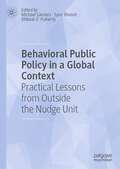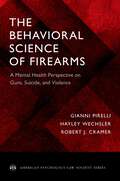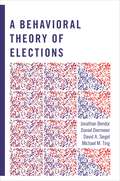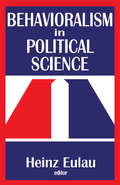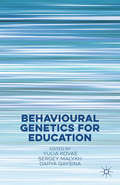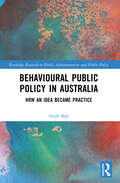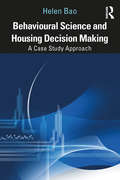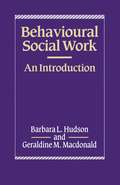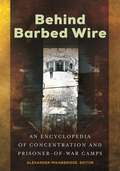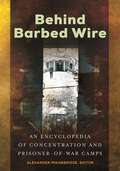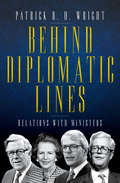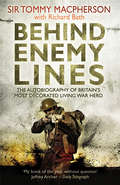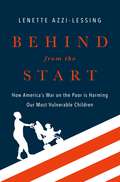- Table View
- List View
Behavioral Public Policy in a Global Context: Practical Lessons from Outside the Nudge Unit
by Michael Sanders Syon Bhanot Shibeal O' FlahertyThe academic field of behavioral science has developed rapidly in recent decades. The field draws on research from across the social and natural sciences, and it has consistently shown that humans are not always rational. This insight has had a profound impact on multiple fields, including economics, political science, and law. Since the early 2000s, the application of behavioral science to public policy has also grown exponentially. Policymakers and practitioners now regularly use behavioral science to rethink how they develop programs and solve social problems. The impact has been far-reaching; behavioral science has transformed how we think about the economy, public health, education, and beyond. In practice, behavioral insights have been used to raise tax revenues, help people access social welfare program benefits and employment opportunities, increase voter turnout, boost medication adherence, and more. There are now hundreds of entities – international organizations, governments, business, and nonprofits – building and investing in internal behavioral science teams. Unfortunately, most of the hard work of putting these teams together and applying behavioral science insights happens “behind the scenes.” This book unearths some of the stories and insights from pioneers in applied behavioral science, in their own words. How did their teams come about, and how did they grow? What projects have worked, and which have not? What have they learned, and what would they recommend to others seeking to build behavioral science teams of their own?
The Behavioral Science of Firearms: A Mental Health Perspective on Guns, Suicide, and Violence (American Psychology-Law Society Series)
by Gianni Pirelli Hayley Wechsler Robert J. CramerThe Behavioral Science of Firearms focuses on applying behavioral science principles and knowledge to inform and improve firearm-related policy, practice, and research. The authors provide comprehensive coverage of relevant case law and legal statutes, as well as issues pertaining to violence, suicide, and gun safety. Additional topics include civilian firearm ownership suitability; considerations for relevant professions (such as the military, law enforcement, and corrections); self-care; and more. Concepts are presented via a best-practices model that promotes empirically-supported decision-making. Drawing on a range of arenas such as psychology, sociology, criminal justice, and law, The Behavioral Science of Firearms is an essential resource for a wide readership, including practitioners, institutional and law enforcement personnel, legislators, and academicians and students in fields such as psychology, criminal justice, and public health.
The Behavioral Science of Firearms: A Mental Health Perspective on Guns, Suicide, and Violence (American Psychology-Law Society Series)
by Gianni Pirelli Hayley Wechsler Robert J. CramerThe Behavioral Science of Firearms focuses on applying behavioral science principles and knowledge to inform and improve firearm-related policy, practice, and research. The authors provide comprehensive coverage of relevant case law and legal statutes, as well as issues pertaining to violence, suicide, and gun safety. Additional topics include civilian firearm ownership suitability; considerations for relevant professions (such as the military, law enforcement, and corrections); self-care; and more. Concepts are presented via a best-practices model that promotes empirically-supported decision-making. Drawing on a range of arenas such as psychology, sociology, criminal justice, and law, The Behavioral Science of Firearms is an essential resource for a wide readership, including practitioners, institutional and law enforcement personnel, legislators, and academicians and students in fields such as psychology, criminal justice, and public health.
A Behavioral Theory of Elections
by Jonathan Bendor Daniel Diermeier David A. Siegel Michael M. TingMost theories of elections assume that voters and political actors are fully rational. While these formulations produce many insights, they also generate anomalies--most famously, about turnout. The rise of behavioral economics has posed new challenges to the premise of rationality. This groundbreaking book provides a behavioral theory of elections based on the notion that all actors--politicians as well as voters--are only boundedly rational. The theory posits learning via trial and error: actions that surpass an actor's aspiration level are more likely to be used in the future, while those that fall short are less likely to be tried later. Based on this idea of adaptation, the authors construct formal models of party competition, turnout, and voters' choices of candidates. These models predict substantial turnout levels, voters sorting into parties, and winning parties adopting centrist platforms. In multiparty elections, voters are able to coordinate vote choices on majority-preferred candidates, while all candidates garner significant vote shares. Overall, the behavioral theory and its models produce macroimplications consistent with the data on elections, and they use plausible microassumptions about the cognitive capacities of politicians and voters. A computational model accompanies the book and can be used as a tool for further research.
A Behavioral Theory of Elections (PDF)
by Jonathan Bendor Daniel Diermeier David A. Siegel Michael M. TingMost theories of elections assume that voters and political actors are fully rational. While these formulations produce many insights, they also generate anomalies--most famously, about turnout. The rise of behavioral economics has posed new challenges to the premise of rationality. This groundbreaking book provides a behavioral theory of elections based on the notion that all actors--politicians as well as voters--are only boundedly rational. The theory posits learning via trial and error: actions that surpass an actor's aspiration level are more likely to be used in the future, while those that fall short are less likely to be tried later. Based on this idea of adaptation, the authors construct formal models of party competition, turnout, and voters' choices of candidates. These models predict substantial turnout levels, voters sorting into parties, and winning parties adopting centrist platforms. In multiparty elections, voters are able to coordinate vote choices on majority-preferred candidates, while all candidates garner significant vote shares. Overall, the behavioral theory and its models produce macroimplications consistent with the data on elections, and they use plausible microassumptions about the cognitive capacities of politicians and voters. A computational model accompanies the book and can be used as a tool for further research.
Behavioralism in Political Science
by Richard J. GellesChanges in the thinking of science are usually accompanied by lively intellectual conflicts between opposing or divergent points of view. The clash of ideas is a major ingredient in the stimulation of the life of the mind in human culture. Such arguments and counter-arguments, of proofs and disproofs, permit changes in the arts and sciences to take place. Political science is not exempt from these conflicts.Since the middle of the twentieth century, the study of politics has been rocked by disagreements over its scope, theories, and methods. These disagreements were somewhat less frequent than in most sciences, natural or behavioral, but they have been at times bitter and persuasive. The subject matter of political science politics and all that is involved in politics has a halo effect. The stakes of politics make people fight and sometimes die for what they claim as their due. Political scientists seem to confuse academic with political stakes, behaving as if the victories and defeats on the battleground of the intellect resemble those on the battleground of political life.Three issues seem critical to political science at the time this volume first appeared in the 1960s: First, disagreement over the nature of the knowledge of political things is a science of politics possible, or is the study of politics a matter of philosophy? Second, controversy over the place of values in the study of politics a controversy that makes for a great deal of confusion. Third, disagreements over the basic units of analysis in the study of politics‘should the political scientist study individual and collective behavior, or limit the work to the study of institutions and large-scale processes? This collection brings together the most persuasive writings on these topics in the mid-1960s.
Behavioralism in Political Science
by Richard J. GellesChanges in the thinking of science are usually accompanied by lively intellectual conflicts between opposing or divergent points of view. The clash of ideas is a major ingredient in the stimulation of the life of the mind in human culture. Such arguments and counter-arguments, of proofs and disproofs, permit changes in the arts and sciences to take place. Political science is not exempt from these conflicts.Since the middle of the twentieth century, the study of politics has been rocked by disagreements over its scope, theories, and methods. These disagreements were somewhat less frequent than in most sciences, natural or behavioral, but they have been at times bitter and persuasive. The subject matter of political science politics and all that is involved in politics has a halo effect. The stakes of politics make people fight and sometimes die for what they claim as their due. Political scientists seem to confuse academic with political stakes, behaving as if the victories and defeats on the battleground of the intellect resemble those on the battleground of political life.Three issues seem critical to political science at the time this volume first appeared in the 1960s: First, disagreement over the nature of the knowledge of political things is a science of politics possible, or is the study of politics a matter of philosophy? Second, controversy over the place of values in the study of politics a controversy that makes for a great deal of confusion. Third, disagreements over the basic units of analysis in the study of politics‘should the political scientist study individual and collective behavior, or limit the work to the study of institutions and large-scale processes? This collection brings together the most persuasive writings on these topics in the mid-1960s.
Behavioural Economics and Terrorism: Law Enforcement and Patterns of Behaviour
by Peter J. Phillips Gabriela PohlBehavioural Economics and Terrorism can be used as a guide to help us think about thinking and, in doing so, to appreciate the deep quirkiness of human behaviour. Each day, people draw on their understanding of human behaviour. This takes place subconsciously for the most part but as situations become more complex it becomes necessary to think more deliberately about how people make their decisions. This book can be used to better understand human action in such contexts. In the high-stakes world of counter-terrorism, every angle of advantage is critical. From terrorists’ operational choices to the way that information flows through intelligence agencies, the book explains the patterns of behaviour that systematically shape human decision-making, for good and for bad. Decision-makers’ use of reference points, their loss aversion, overconfidence, goals and aspirations all shape their choices under conditions of risk and uncertainty. This book helps to shed light on how to use these concepts (and more) to develop deeper insights into the way in which terrorists think about their attack methods and targets.
Behavioural Economics and Terrorism: Law Enforcement and Patterns of Behaviour
by Peter J. Phillips Gabriela PohlBehavioural Economics and Terrorism can be used as a guide to help us think about thinking and, in doing so, to appreciate the deep quirkiness of human behaviour. Each day, people draw on their understanding of human behaviour. This takes place subconsciously for the most part but as situations become more complex it becomes necessary to think more deliberately about how people make their decisions. This book can be used to better understand human action in such contexts. In the high-stakes world of counter-terrorism, every angle of advantage is critical. From terrorists’ operational choices to the way that information flows through intelligence agencies, the book explains the patterns of behaviour that systematically shape human decision-making, for good and for bad. Decision-makers’ use of reference points, their loss aversion, overconfidence, goals and aspirations all shape their choices under conditions of risk and uncertainty. This book helps to shed light on how to use these concepts (and more) to develop deeper insights into the way in which terrorists think about their attack methods and targets.
Behavioural Genetics for Education
by Yulia Kovas Sergey Malykh Darya GaysinaEducational environments interact with children's unique genetic profiles, leading to wide individual differences in learning ability, motivation, and achievement in different academic subjects – even when children study with the same teacher, attend the same school and follow the same curriculum. This book considers how education can benefit from the recent progress in genetically informative research. The book provides new insights into the origins of individual differences in education traits such as cognitive abilities and disabilities; motivation and personality; behavioural and emotional problems; social functioning; well-being, and academic achievement. Written and edited by international interdisciplinary experts, this book will be of interest to teachers, parents, educational and developmental psychologists, policy makers and researchers in different fields working on educationally-relevant issues.
Behavioural Policies for Health Promotion and Disease Prevention (Palgrave Studies in Public Health Policy Research)
by Benjamin Ewert Kathrin LoerPolicy-making in public health is highly complex, which is one reason why the behavioural turn is now playing a significant role in this field. Against this backdrop, this book aims to develop a theoretical understanding of how policymakers take up public health challenges and how policies change over the course of time. Accordingly, the book reveals policy-makers' underlying assumptions, which influence the way in which public policy seeks to promote the health status of citizens. In a second step, the book presents a typology of policy instruments and applies this to the field of health promotion. This typology introduces an option that adds behaviourally informed insights to the toolbox of political analysis. Empirical evidence of behavioural health policies can be found in various countries around the world, and the book presents both relevant country studies and examples from the supra- and international level. Finally, the book discusses the implications of the rise of behavioural health policies, proposes a specific concept of health citizenship and reviews state-citizen relations. The book is useful for academics from health-related disciplines, such as political science, sociology, and public health, as well as for policy-makers, practitioners and students.
Behavioural Public Finance: Individuals, Society, and the State (Routledge International Studies in Money and Banking)
by Larissa Batrancea Sava 351 Çevik M. Mustafa Erdoğ DuThis book tackles political, social, and behavioural aspects of public finance and fiscal exchange. The book combines conventional approaches toward public finance with new developments in economics such as political governance, social and individual aspects of economic behaviour. It colligates public finance and behavioural economics and gathers original contributions within the emerging field of behavioural public finance. The book addresses public finance topics by incorporating political, social, and behavioural aspects of economic decision-making, assuming the tax relationship is shaped by three dimensions of decision-making. Thus, it aims not only to reflect the interdisciplinary nature of public finance by bringing together scholars from various disciplines but also to examine public finance through the lens of political, social, and behavioural aspects. The book scrutinizes the relationship between political institutions, governance types, and public finance; it investigates the impact of social context, social capital, and societal cooperation on public finance; it explores behavioural biases of individual fiscal preferences. This book is of interest to scholars, policymakers, tax professionals, business professionals, financers, university students, and researchers in the fields of public policy and economics.
Behavioural Public Policy in Australia: How an Idea Became Practice (Public Administration and Public Policy)
by Sarah BallUsing rich ethnographic data and first-hand experience, Ball presents a detailed account of Australia’s attempts to incorporate behavioural insights into its public policy. Ball identifies three competing interpretations of behavioural public policy, and how these interpretations have influenced the use of this approach in practice. The first sees the process as an opportunity to introduce more rigorous evidence. The second interpretation focuses on increasing compliance, cost savings and cutting red tape. The last focuses on the opportunity to better involve citizens in policy design. These interpretations demonstrate different ‘solutions’ to a series of dilemmas that the Australian Public Service, and others, have confronted in the last 50 years, including growing politicisation, technocracy and a disconnect from the needs of citizens. Ball offers a detailed account of how these priorities have shaped how behavioural insights have been implemented in policy-making, as well as reflecting on the challenges facing policy work more broadly. An essential read for practitioners and scholars of policy-making, especially in Australia.
Behavioural Public Policy in Australia: How an Idea Became Practice (Public Administration and Public Policy)
by Sarah BallUsing rich ethnographic data and first-hand experience, Ball presents a detailed account of Australia’s attempts to incorporate behavioural insights into its public policy. Ball identifies three competing interpretations of behavioural public policy, and how these interpretations have influenced the use of this approach in practice. The first sees the process as an opportunity to introduce more rigorous evidence. The second interpretation focuses on increasing compliance, cost savings and cutting red tape. The last focuses on the opportunity to better involve citizens in policy design. These interpretations demonstrate different ‘solutions’ to a series of dilemmas that the Australian Public Service, and others, have confronted in the last 50 years, including growing politicisation, technocracy and a disconnect from the needs of citizens. Ball offers a detailed account of how these priorities have shaped how behavioural insights have been implemented in policy-making, as well as reflecting on the challenges facing policy work more broadly. An essential read for practitioners and scholars of policy-making, especially in Australia.
Behavioural Science and Housing Decision Making: A Case Study Approach
by Helen BaoThis book takes a behavioural approach to examine six important housing questions: tenure decision, gentrification, place attachment, housing bubbles, housing wealth, and residential satisfaction. Using experimental and field data, the book demonstrates the effects of six behavioural biases and heuristics (i.e., anchoring and reference dependence, loss aversion, mental accounting, endowment effect, herd behaviours, and social comparison) on these housing decisions. The first part of the book introduces the questions and provides a behavioural science toolbox before the second part adopts a real-world case study approach. Real data sets and suggested answers are provided, and the cases come from the UK, USA, and China. Background information is given in each case to facilitate the understanding of the case data and question, as well as the discussions on the results. This book is ideal supplementary reading on a variety of courses such as housing studies, economics, real estate, research methods, and for students and academics who are interested in the application of behavioural science in housing decisions.
Behavioural Science and Housing Decision Making: A Case Study Approach
by Helen BaoThis book takes a behavioural approach to examine six important housing questions: tenure decision, gentrification, place attachment, housing bubbles, housing wealth, and residential satisfaction. Using experimental and field data, the book demonstrates the effects of six behavioural biases and heuristics (i.e., anchoring and reference dependence, loss aversion, mental accounting, endowment effect, herd behaviours, and social comparison) on these housing decisions. The first part of the book introduces the questions and provides a behavioural science toolbox before the second part adopts a real-world case study approach. Real data sets and suggested answers are provided, and the cases come from the UK, USA, and China. Background information is given in each case to facilitate the understanding of the case data and question, as well as the discussions on the results. This book is ideal supplementary reading on a variety of courses such as housing studies, economics, real estate, research methods, and for students and academics who are interested in the application of behavioural science in housing decisions.
Behind a Veil of Ignorance?: Power and Uncertainty in Constitutional Design (Studies in Public Choice #32)
by Louis M. Imbeau Steve JacobThis volume is a very interesting research project that includes the most careful work on constitutional power and limits to authority of which I am aware. In general, the contributors find that constitutional negotiations normally took place in settings where uncertainty was considerable. They also find that the more detailed the characterization of power relationships, the more liberal and durable the democracy tends to be. Roger D. CongletonThis book addresses the issue of the impact of uncertainty in constitutional design. To what extent do constitution drafters and adopters make their decisions behind a veil of ignorance? More fundamentally, can we infer from constitutional texts the degree of uncertainty faced by constitution drafters and adopters? After an introduction (chapter 1), the book proceeds in two parts. The first part (chapters 2 to 4) introduces to the intellectual filiation of the project and to its theoretical and methodological foundations. The second part (chapters 5 to 13) presents nine case studies built on the same structure: historical account of the making of the Constitution, results of the content analysis of the constitutional text, and discussion of specific issues raised in the analysis. Chapter 14 concludes.
Behind Barbed Wire: An Encyclopedia of Concentration and Prisoner-of-War Camps
by Alexander MikaberidzeAn indispensable reference on concentration camps, death camps, prisoner-of-war camps, and military prisons offering broad historical coverage as well as detailed analysis of the nature of captivity in modern conflict.This comprehensive reference work examines internment, forced labor, and extermination during times of war and genocide, with a focus on the 20th and 21st centuries and particular attention paid to World War II and recent conflicts in the Middle East. It explores internment as it has been used as a weapon and led to crimes against humanity and is ideal for students of global studies, history, and political science as well as politically and socially aware general readers.In addition to entries on such notorious camps as Abu Ghraib, Andersonville, Auschwitz, and the Hanoi Hilton, the encyclopedia includes profiles of key perpetrators of camp and prison atrocities and more than a dozen curated and contextualized primary source documents that further illuminate the subject. Primary sources include United Nations documents outlining the treatment of prisoners of war, government reports of infamous camp and prison atrocities, and oral histories from survivors of these notorious facilities.
Behind Barbed Wire: An Encyclopedia of Concentration and Prisoner-of-War Camps
by Editor Alexander MikaberidzeAn indispensable reference on concentration camps, death camps, prisoner-of-war camps, and military prisons offering broad historical coverage as well as detailed analysis of the nature of captivity in modern conflict.This comprehensive reference work examines internment, forced labor, and extermination during times of war and genocide, with a focus on the 20th and 21st centuries and particular attention paid to World War II and recent conflicts in the Middle East. It explores internment as it has been used as a weapon and led to crimes against humanity and is ideal for students of global studies, history, and political science as well as politically and socially aware general readers.In addition to entries on such notorious camps as Abu Ghraib, Andersonville, Auschwitz, and the Hanoi Hilton, the encyclopedia includes profiles of key perpetrators of camp and prison atrocities and more than a dozen curated and contextualized primary source documents that further illuminate the subject. Primary sources include United Nations documents outlining the treatment of prisoners of war, government reports of infamous camp and prison atrocities, and oral histories from survivors of these notorious facilities.
Behind Closed Doors
by Tara Taylor QuinnClosing the door doesn't always keep you safe… Laura Elizabeth Clark saw herself as a peacemaker. Until the day she went against her parents' wishes and married Harry Kendall, a brilliant history professor who happens to be black.
Behind Closed Doors: The Tragic, Untold Story Of The Duchess Of Windsor
by Hugo VickersHugo Vickers has an encyclopaedic knowledge of the Royal Family, and has had a fascination with the story of the Duchess of Windsor since he was a young man. There have been a number of books about this doomed couple, but this book brings a new perspective on the story by focussing on the later years of exile.While Vickers has his own theories about the Abdication itself, and he makes it very clear that Mrs Simpson did not lure the King from the throne, the drama of this narrative comes from the criminal exploitation of an old sick woman after the death of her husband. She was ruthlessly exploited by a French lawyer called Suzanne Blum. Some members of the Royal Family, like Mountbatten and the Queen Mother, don't emerge with much credit either.Hugo Vickers relates a tragic story which has lost none of its resonance over the years since the Duchess died in 1986.
Behind Diplomatic Lines: Relations with Ministers
by Lord Wright of R Patrick WrightPatrick Wright’s memoir opens on a diplomatic crisis. A growing number of countries are threatening to boycott the Commonwealth Games in protest of the British government’s handling of South African apartheid. And the problems only get worse.Patrick Wright was one of the pre-eminent diplomats of his day, putting him at the forefront of some of the late twentieth century’s most important global events. His six years at the FCO found him dealing with the backlash from the Falklands War, the collapse of the Soviet Union, strained relations with the EU, the First Gulf War and, perhaps most challenging of all, the ‘fire and glares’ of Prime Minister Margaret Thatcher.Lord Wright’s account is not only an essential documentation of a significant historical period, but witty and entertaining throughout. He revels in gossip, despairs at the mischievous press ‘painting lurid pictures of Britain versus the Rest’, recalls numerous amusing scenarios and is rather brutal in his assessment of various high-profile political figures.
Behind Enemy Lines: The Autobiography of Britain's Most Decorated Living War Hero
by Richard Bath Sir Tommy MacphersonWith three Military Crosses, three Croix de guerre, a Légion d'honneur and a papal knighthood for his heroics during the Second World War, Sir Tommy Macpherson is the most decorated living soldier of the British Army. Yet for 65 years the Highlander's story has remained untold. Few know how, aged 21, he persuaded 23,000 SS soldiers of the feared Das Reich tank column to surrender, or how Tommy almost single-handedly stopped Tito's Yugoslavia annexing the whole of north-east Italy. Twice captured, he escaped both times, marching through hundreds of miles of German-held territory to get home. Still a schoolboy when war broke out, Tommy quickly matured into a legendary commando, and his remarkable story features a dizzyingly diverse cast of characters, including Winston Churchill, Field Marshal Montgomery and Charles de Gaulle.
Behind from the Start: How America's War on the Poor is Harming Our Most Vulnerable Children
by Lenette Azzi-LessingToday there are nearly six million children under the age of five living in poverty in the world's richest country. Blanket statements are often tossed around in the political arena, public debate sphere, and progressive rhetoric. But the statistic remains intangible for many Americans, likely because the root causes, effects, and implications are multifaceted and complex, and are often hard to understand for the average American living a much different reality. What is needed is a clear and thorough discussion of this epidemic, and Behind from the Start answers that call. Author Lenette Azzi-Lessing examines what lies behind the stubbornly high rate of poverty among young children in the U.S. and the resulting consequences, both for the children themselves and for America as a whole. Behind from the Start examines the link between America's shaming, blaming, and marginalizing of poor parents, and our punitive welfare policies that jeopardize the life chances of vulnerable young children, thereby maintaining the cycle of chronic poverty. Research has shown that the experience of poverty in the first years of life is particularly harmful, blunting physical and brain development, increasing the risk for chronic health issues and injury, and limiting a person's lifelong capacity for learning and success. In debunking the myths that help perpetuate the cycle of poverty in the world's richest country, Lenette Azzi-Lessing reveals how negative public and political discourse regarding poor families impacts the poorly conceived and fragmented programs intended to support them, which have in turn failed to meet their aims. She considers the cultural and political forces that contribute to intergenerational poverty in the U.S., the consequences for the millions of young children in families stuck at the bottom of our economy, and the beneficial impacts that would be felt country-wide in fixing some of these persistent problems. Drawing upon knowledge from diverse fields, including neuroscience, media studies, and public policy, as well as the author's experiences on the front lines as a practicing social worker, Behind from the Start offers a fresh take on this shameful problem and its solutions.
